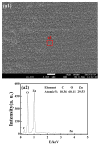Comparison of the Corrosion Behavior of Brass in TiO2 and Al2O3 Nanofluids
- PMID: 32486005
- PMCID: PMC7352605
- DOI: 10.3390/nano10061046
Comparison of the Corrosion Behavior of Brass in TiO2 and Al2O3 Nanofluids
Abstract
The corrosion behavior of brass in TiO2 and Al2O3 nanofluids using a simulated cooling water (SCW) as the base solution and sodium dodecyl benzene sulfonate (SDBS) as the dispersant was studied by electrochemical measurements and surface analysis in this paper. It was found that SDBS could be adsorbed on the brass surface to form a protective film and have a corrosion inhibition effect on brass in SCW. In the SCW-SDBS-TiO2 nanofluid, some negatively charged TiO2 nanoparticles were attached to the brass surface and no obvious SDBS adsorption film was found, and the SDBS in this nanofluid had almost no corrosion inhibition on brass. In the SCW-SDBS-Al2O3 nanofluid, the brass surface was covered by a uniformly distributed SDBS film containing some Al2O3 nanoparticles which were positively charged, and the corrosion inhibition of brass was significantly improved in this nanofluid. It is concluded that the adsorption of SDBS on the brass surface in nanofluids is related to the charge status of the nanoparticles, which makes brass have different corrosion resistance in various nanofluids.
Keywords: Al2O3 nanofluid; TiO2 nanofluid; brass; corrosion; sodium dodecyl benzene sulfonate.
Conflict of interest statement
The authors declare no conflict of interest.
Figures








References
-
- Sidik N.A.C., Mohammed H.A., Alawi O.A., Samion S. A review on preparation methods and challenges of nanofluids. Int. Commun. Heat Mass Transf. 2014;54:115–125. doi: 10.1016/j.icheatmasstransfer.2014.03.002. - DOI
-
- Hwang Y., Lee J.-K., Lee C.H., Jung Y., Cheong S., Lee C., Ku B., Jang S. Stability and thermal conductivity characteristics of nanofluids. Thermochim. Acta. 2007;455:70–74. doi: 10.1016/j.tca.2006.11.036. - DOI
-
- Kumar S., Dinesha P., Gaggad A., Mehrotra K. Performance investigation of an automotive car radiator operated with nanofluid based coolant. Heat Transf. Res. 2018;49:1527–1543. doi: 10.1615/HeatTransRes.2018020810. - DOI
-
- Zamzamian A., KeyanpourRad M., KianiNeyestani M., Jamal-Abad M.T. An experimental study on the effect of Cu-synthesized/EG nanofluid on the efficiency of flat-plate solar collectors. Renew. Energy. 2014;71:658–664. doi: 10.1016/j.renene.2014.06.003. - DOI
-
- Bi S., Guo K., Liu Z., Wu J. Performance of a domestic refrigerator using TiO2-R600a nano-refrigerant as working fluid. Energy Convers. Manag. 2011;52:733–737. doi: 10.1016/j.enconman.2010.07.052. - DOI
Grants and funding
LinkOut - more resources
Full Text Sources

